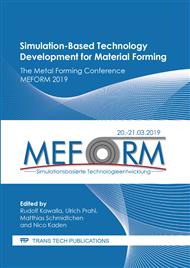[1]
V. C. Igwemezie, P. C. Agu, Development of Bainitic Steels for Engineering Applications, Int. J. Eng. Res. Tech. 2 (2014) 2698-2711.
Google Scholar
[2]
H. K. D. H. Bhadeshia, The bainite transformation: unresolved issues, Mat. Sci. Eng. A (1999) 58-66.
Google Scholar
[3]
R. F. Hehemann, The bainite reaction, Am. Soc. Met. (1970) 397-432.
Google Scholar
[4]
A. Matsuzaki, H. K. D. H. Bhadeshia, Effect of austenite grain size and bainite morphology on overall kinetics of bainite transformation in steels, Mat. Sci. Tech. 5 (2013) 518-522.
DOI: 10.1179/026708399101506210
Google Scholar
[5]
P. Shipway, H. K. D. H. Bhadeshia, Mechanical stabilisation of bainite, Mat. Sci. Tech. 11 (1995) 1116-1128.
Google Scholar
[6]
S. J. Lee, J. S. Park, Y. K. Lee, Effect of austenite grain size on the transformation kinetics of upper and lower bainite in a low-alloy steel, Scr. Mat. 1 (2008) 87-90.
DOI: 10.1016/j.scriptamat.2008.02.036
Google Scholar
[7]
C. Y. Huang, J. R. Yang, S. C. Wang, Effect of Compressive Deformation on the Transformation Behavior of an Ultra-Low-Carbon Bainitic Steel, Mat. Trans. 8 (1993) 658-668.
DOI: 10.2320/matertrans1989.34.658
Google Scholar
[8]
F. G. Caballero, C. Capdevila, J. Chao, J. Cornide, C. Garcia-Mateo, H. Roelofs, S. Hasler, G. Mastrogiacomo, The microstructure of continuously cooled tough bainitic steel. International Conference Super-High Strength Steels. Milano (2010).
DOI: 10.1179/1743284710y.0000000047
Google Scholar
[9]
J. B. Leblond, J. Devaux, A new kinetic model for anisothermal metallurgical transformations in steels including effect of austenite tgrain size, Acta metall. mater. 1 (1984) 137-146.
DOI: 10.1016/0001-6160(84)90211-6
Google Scholar
[10]
M. Azuma, M. Fujita, M. Takahashi, T. Senuma, D. Quidort, T. Lung, Modelling Upper and Lower Bainite Transformation in Steels, ISIJ International. 2 (2005) 221-228.
DOI: 10.2355/isijinternational.45.221
Google Scholar
[11]
D. Hömberg, A numerical simulataion of the jominy end-quench test, Acta Mat. 11 (1996) 4375-4385.
DOI: 10.1016/1359-6454(96)00084-5
Google Scholar
[12]
P. Suwanpinij, N. Togobytska, U. Prahl, W. Weiss, D. Hömberg, W. Bleck, Numerical Cooling Strategy Design for Hot Rolled Dual Phase Steel, Ste. Res. Int. 11 (2010) 1001-1009.
DOI: 10.1002/srin.201000091
Google Scholar
[13]
P. Suwanpinij, X. Li, U. Prahl, W. Bleck, Modeling Bainite Transformation and Retained Austenite in Hot Rolled TRIP Steel by Instantaneous Carbon Enrichment, steel research int. 12 (2017) 1700122.
DOI: 10.1002/srin.201700122
Google Scholar
[14]
M. Takahashi, H. K. D. H. Bhadeshia, A Model for the Microstructure of Some Advanced Bainitic Steels, Mat. Trans. 8 (1991) 689-696.
DOI: 10.2320/matertrans1989.32.689
Google Scholar
[15]
M. Menzel, Anwendungsspezifische Gefügeentwicklung in mikrolegiertem bainitischem Warmband. RWTH Aachen. Aachen (not published yet).
Google Scholar
[16]
R. Barbosa, F. Boratto, S. Yue, J. J. Jonas, The influence of chemical composition on the recrystallisation behaviour of microalloyed steels, International symposium on processing, microstructure and properties of HSLA steel (1988) 51-61.
Google Scholar
[17]
M. P. Phaniraj, Y.-M. Shin, W.-S. Jung, M.-H. Kim, I.-S. Choi, Understanding dual precipitation strengthening in ultra-high strength low carbon steel containing nano-sized copper precipitates and carbides, Nano convergence. 1 (2017) 16.
DOI: 10.1186/s40580-017-0110-5
Google Scholar
[18]
Z. Wang, X. Mao, Z. Yang, X. Sun, Q. Yong, Z. Li, Y. Weng, Strain-induced precipitation in a Ti micro-alloyed HSLA steel, Materials Science and Engineering: A (2011) 459-467.
DOI: 10.1016/j.msea.2011.09.062
Google Scholar
[19]
H. K. D. H. Bhadeshia, Atomic Mechanism of the Bainite Transformation, HTM. 6 (2017) 340-345.
Google Scholar
[20]
H. F. Lan, L. X. Du, X. H. Liu, Microstructure and Mechanical Properties of a Low Carbon Bainitic Steel, steel research int. 4 (2013) 352-361.
DOI: 10.1002/srin.201200186
Google Scholar
[21]
S. Chatterjee, H.-S. Wang, J. R. Yang, H. K. D. H. Bhadeshia, Mechanical stabilisation of austenite, Mat. Sci. Tech. 6 (2013) 641-644.
Google Scholar


